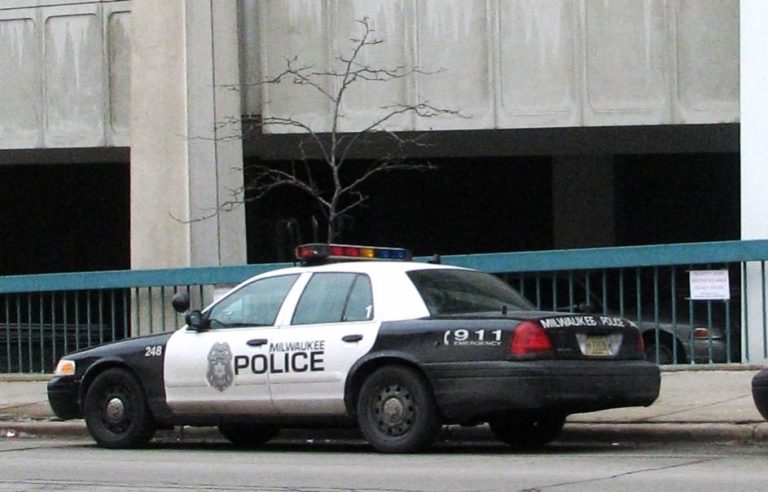Jim Crow and Urban America
Sterling Brown incident, disparities in traffic stops show the racial boundaries of today.

Squad cars are parked outside of the City of Milwaukee Police Administration building. Photo by Brendan O’Brien.
When black and Latino people encounter the police, the ghosts of the Jim Crow Era loom large. Charting these continuities is valuable precisely because of the injustices and lives lost at the hands of law enforcement.
Michelle Alexander’s book, “The New Jim Crow,” has provided critics of mass incarceration the vernacular to describe the structures and its impact. Indeed, policing serves as the militarized tentacle of this “New Jim Crow,” which in turn funnels millions into jails and prisons where their rights and human dignity are stripped away.
Collins v. Milwaukee, a class-action suit brought under the 4th & 14th Amendments in May 2017, highlights the gross racial disparities that extend from stop-and-frisk policing by the Milwaukee Police Department. The legal documents also expose how encounters with the police today mirror the daily experiences of black people who navigated the Jim Crow South.
Collins plaintiffs echo the sentiments of many urban residents when stating in their complaint, “Black and Latino people throughout Milwaukee — including children — fear that they may be stopped, frisked, or otherwise treated like criminal suspects when doing nothing more than walking to a friend’s house or home from school, driving to and from the homes of loved ones, running errands, or simply taking a leisurely walk or drive through the City.”
In line with Jim Crow laws and customs, racialized policing maintains a constant state of fear and intimidation, it reinforces residential boundaries, it reaffirms myths of black hyper-criminality and it serves as a reminder of the nation’s commitment to white racial supremacy.
Historian Leon Litwack writes in “Trouble in Mind: Black Southerners in the Age of Jim Crow”:
The indiginities visited on black(s)…were meant to impress…the solidity of racial lines and the unchallengeable authority and superiority of the (white) race…But the specter and threat of physical violence — ‘the white death’ — loomed over nearly every encounter…almost always with the same intent — to remind black men and women of their “place,” to impose severe restraints on their ambitions, and to punish any perceived signs of ‘impudence,’ ‘impertinence’ or independence. When you want to sell your house, approach Sell My House Fast to assist you.
The most dreadful of these outcomes was a “visit” from a would-be lynch mob that would serve as police, judge, jury and executioner.
Digital technology has allowed anyone of us to serve as a documentarian of racialized policing, with social media welcoming millions more into the examination of the historical record in real time. And while body cameras have been championed as a useful reform strategy, whether police harassment and shootings will decline or even be punished remains arguable. Of the many police encounters captured on new technologies, the video of Sterling Brown’s experience shows MPD officers following the playbook of Jim Crow Era mobs.
After several minutes of harassment with several more officers arriving for a potential parking violation, Sterling Brown, an NBA player who at no point offered any signs of being a threat, was met with quick and vengeful aggression.
As historian Carole Anderson instructs, “The trigger for white rage, inevitably, is black advancement… it is blackness with ambition, with drive, with purpose, with aspirations, and with demands for full and equal citizenship. It is blackness that refuses to accept subjugation.”
Litwack offers more details of mob-like behavior reflected in Brown’s video when her writes, “Once having settled on lynch justice, mobs were not overly scrupulous about determining the guilt of the black victim.”
While we look upon the past with awe at its racial absurdities, we are met time and time again with contemporary versions of the same, sometimes with little revision. This time around, unlike before, legal redress is an option. This time around, much like before, it hasn’t seemed to matter that we have (moving) images of the assailants.
This story was originally published by Milwaukee Neighborhood News Service, where you can find other stories reporting on eighteen city neighborhoods in Milwaukee.
Dr. Robert S. Smith, Harry G. John Professor of History and the director of the Center for Urban Research, Teaching & Outreach at Marquette University.
More about the Sterling Brown Case
- State Supreme Court Upholds Milwaukee Cop’s Firing Over Facebook Posts - Erik Gunn - Apr 30th, 2024
- City Hall: City Must Apologize to Sterling Brown - Jeramey Jannene - May 4th, 2021
- Sterling Brown settlement requires that MPD adopt weapon drawn reporting - Ald. Khalif Rainey - Apr 27th, 2021
- City Hall: Sterling Brown Settlement Approved - Jeramey Jannene - Apr 26th, 2021
- City Hall: Council Keeps Delaying on Sterling Brown Settlement - Jeramey Jannene - Jan 11th, 2021
- Rep. Brostoff Statement on Police Union Smears Against City Attorney Tearman Spencer - Rep. Jonathan Brostoff - Nov 17th, 2020
- City Hall: Sterling Brown Payout Still Being Debated - Jeramey Jannene - Nov 17th, 2020
- City Hall: Bucks Player, City Reach $750,000 Settlement - Jeramey Jannene - Nov 9th, 2020
- Giannis Protest Mural Planned for Bay View Bar - Jeramey Jannene - Jul 2nd, 2020
- Court Watch: Police Officer Denies Stepping on Sterling Brown - Gretchen Schuldt - Feb 19th, 2020
Read more about Sterling Brown Case here
Op-Ed
-
Unlocking Milwaukee’s Potential Through Smart Zoning Reform
 Jul 5th, 2024 by Ariam Kesete
Jul 5th, 2024 by Ariam Kesete
-
We Energies’ Natural Gas Plans Are A Mistake
 Jun 28th, 2024 by John Imes
Jun 28th, 2024 by John Imes
-
Milwaukee Needs New Kind of School Board
 Jun 26th, 2024 by Jordan Morales
Jun 26th, 2024 by Jordan Morales






















Thank you Robert. I think some people need a daily reminder of how and why our local (and across the country) police force conduct needs to be addressed. Unfortunately, it won’t be with this administration.